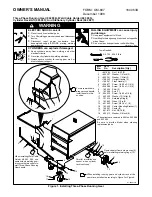
15
measured with the burners operating. To measure and adjust the
manifold pressure, use the following procedure.
1.
Turn OFF gas to furnace at the manual gas shutoff valve
external to the furnace.
2. Turn OFF all electrical power to the system.
3. Outlet pressure tap connections:
a. White-Rodgers valve:
Back outlet pressure test screw (outlet pressure Tap) out
one turn (counterclockwise, not more than one turn).
4. Connect manometer (or appropriate pressure gauge) at the
gas valve outlet pressure tap. See White-Rodgers 36J22Y-
204 gas valve for location of outlet pressure tap.
5. Turn ON the gas supply.
6. Turn ON power and close thermostat “R” and “W” contacts
to provide a call for heat.
7. Using a leak detection solution or soap suds, check for
leaks at outlet pressure Tap screw (White-Rodgers valve).
Bubbles forming indicate a leak. SHUT OFF GAS AND
REPAIR ALL LEAKS IMMEDIATELY!
8.
Measure the gas manifold pressure with burners firing.
Adjust manifold pressure using the following
Manifold Gas
Pressure
table.
Natural Gas
2.8" - 3.2" w.c.
Manifold Gas Pressure
The Manifold Gas Pressure must be within the range specified.
9. Remove regulator cover screw from the outlet pressure
regulator and turn screw clockwise to increase pressure or
counterclockwise to decrease pressure. Replace regulator
cover screw.
10. Turn OFF all electrical power and gas supply to the system.
11.
Remove the manometer hose from the hose barb fitting or
outlet pressure Tap.
12. Replace outlet pressure tap:
a. White-Rodgers valve: Turn outlet pressure test screw in
to seal pressure port (clockwise, 7 in-lb minimum).
13. Turn ON electrical power and gas supply to the system.
14. Close thermostat contacts to provide a call for heat.
15. Retest for leaks. If bubbles form, SHUT OFF GAS AND
REPAIR ALL LEAKS IMMEDIATELY!
Gas BTU Input (Natural Gas Only) Check
To measure the gas input use a gas meter and proceed as
follows:
1.
Turn off gas supply to all other appliances except the unit.
2. With the unit operating, time the smallest dial on the meter
for one complete revolution. If this is a 2 cubic foot dial,
divide the seconds by 2; if it is a 1 cubic foot dial, use the
seconds as is. This gives the seconds per cubic foot of gas
being delivered to the unit.
3. INPUT=GAS HTG VALUE x 3600 / SEC. PER CUBIC FOOT
Example: Natural gas with a heating value of 1000 BTU per
cubic foot and 36 seconds per cubic foot as determined by
Step 2, then:
Input = 1000 x 3600 / 36 = 100,000 BTU per Hour.
NOTE:
BTU content of the gas should be obtained from the
gas supplier. This measured input must not be greater than
shown on the unit rating plate.
4.
Relight all other appliances turned off in step 1. Be sure all
pilot burners are operating.
Temperature Rise Check
Check the temperature rise through the unit by placing
thermometers in supply and return air registers as close to the
unit as possible. Thermometers must not be able to sample
temperature directly from the unit heat exchangers, or false
readings could be obtained.
1.
All registers must be open; all duct dampers must be in their
final (fully or partially open) position and the unit operated
for 15 minutes before taking readings.
2.
The temperature rise must be within the range specified on
the rating plate.
NOTE:
Air temperature rise is the temperature difference
between supply and return air.
With a properly designed system, the proper amount of
temperature rise will normally be obtained when the unit is
operated at rated input with the recommended blower speed.
If the correct amount of temperature rise is not obtained, it may
be necessary to change the blower speed. A higher blower
speed will lower the temperature rise. A slower blower speed will
increase the temperature rise.
NOTE:
Blower speed MUST be set to give the correct air
temperature rise through the unit as marked on the rating plate.
Summary of Contents for DP14U Series
Page 23: ...23 APPENDIX Unit Dimensions...
















































